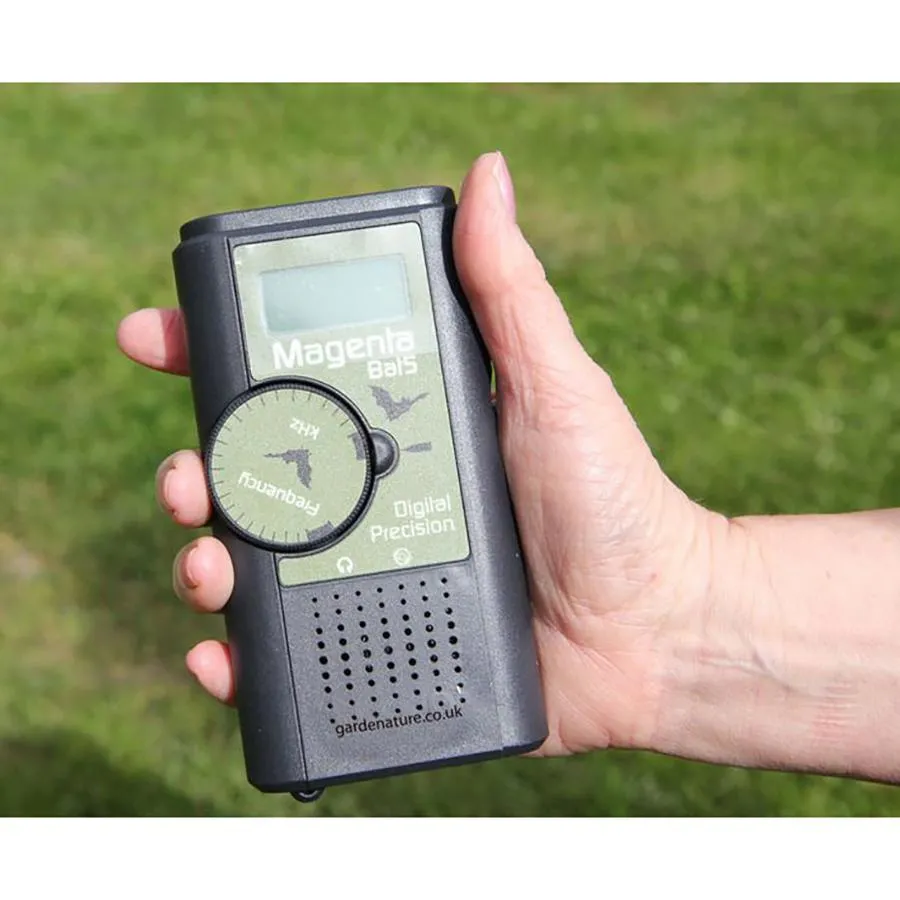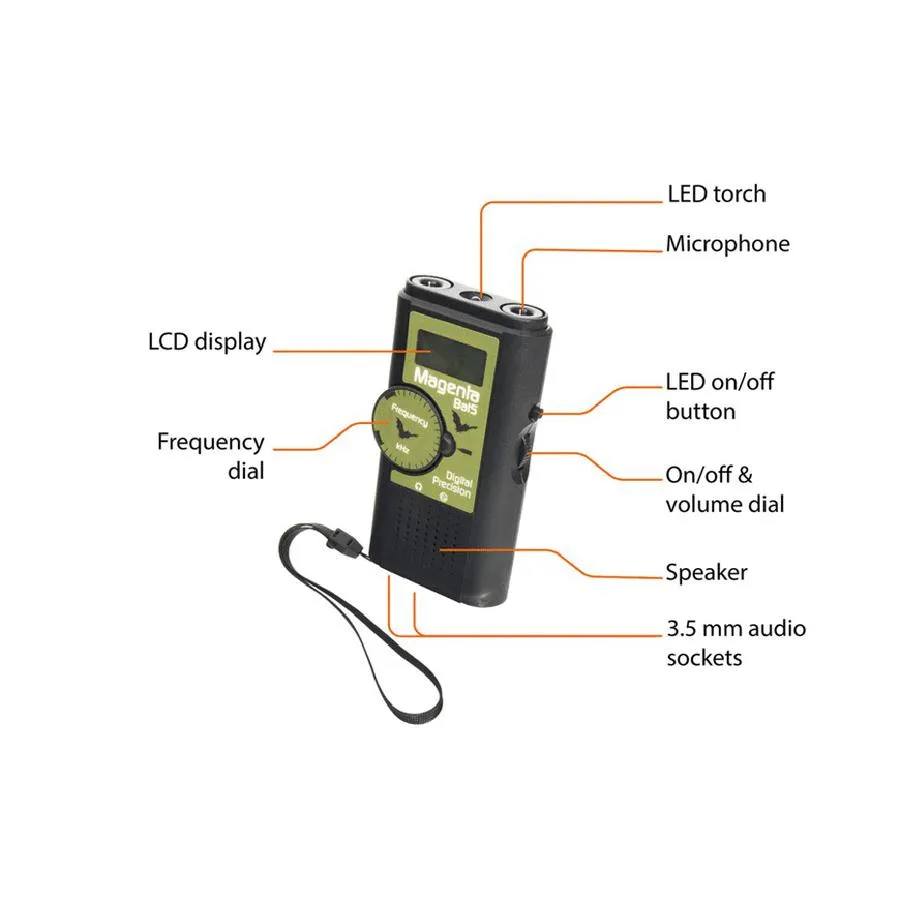Bat Detector 5
The Magenta Bat 5 Digital Quartz Bat Detector has a backlit 4 digit LCD frequency display, a high stability easily tuned local oscillator, advanced amplification and filtering circuits.
Extended 10 - 130kHz frequency range, large 4 digit LCD frequency display with back lighting for easy visibility day and night. Quartz accurate - always calibrated and displaying frequency to within 0.1kHz. it has a front-facing weatherproof speaker, built in LED torch, wrist strap, headphone and recording sockets. A small paper guide is included that assists you in identifying the bat species by frequency.
Magenta Bat 5 Features:
- Highly linear heterodyne oscillator for easy frequency setting
- Display resolution 100Hz - reads 10.0 to 130.0 kHz
- Usable radius upto 100 meters
- Multi-stage active filters for stable loudspeaker operation over the whole frequency range
- Fixed level recorder output socket - before the volume control - simplifies recording
- Headphone socket suitable for any stereo headphones from 8 ohms upwards
- Short circuit proof headphone output
- Wide range equalised microphone - sensitive across the whole frequency range
- Low noise circuit techniques optimised for wide bandwidth with minimum noise
- Designed in Denmark and made in England by Magenta
- Conforms to EU RoHS and WEEE regulations. Lead free
- 2-year manufacturer guarantee
Bat Detector 5 specification:
- Type: Heterodyne
- Frequency Range: 10-130 kHz
- Bandwidth: 9kHz (±4kHz)
- Outputs: 3.5mm stereo headphone socket and 3.5mm stereo jack recording socket
- Output Power: 0.5 Watts
- Tape Output: 100mV typical
- Microphone: Wide band electret
- Speaker: Waterproof low profile mylar
- Size: 135 x 72 x 27 mm
- Power: 4 x AAA batteries (not included)
There are 17 species of bats resident in the UK, that's more than a quarter of our mammal species. British Bats are insect
predators, eating a wide variety of prey including beetles, moths, flies and midges. Bat population levels
and health are considered to be an indicator species of the balance of nature. Lots of healthy bats, mean lots
of invertebrates which rely on healthy vegetation and hence healthy ecosystem.
Although bats have good night vision they locate their prey and objects in the environment by using a pattern of returning echoes from their high frequency ultrasonic calls known as 'echolocation'. Their echolocation skills are so good that they can avoid objects as small as a strand of hair, so there is no likelihood of them touching you whilst they are in flight.
Female bats generally only have one infant per year, forming nursing colonies in trees and buildings in which to raise their young. During the winter months, there is less insect prey available for bats, so during this time they hibernate in trees, buildings or caves, only emerging occasionally to eat or drink.
It is illegal to disturb or handle a bat without a licence
All British bats and their roosts are protected by UK law and it is an offence to handle or intentionally disturb a wild bat unless you possess the appropriate licence. If a building has a bat roost, the building cannot be developed without first contacting the local authority to ensure the mammals are not compromised. These restrictions are vital to ensure these threatened small mammals are afforded as much protection as possible.
Here are some interesting bat facts:
- A tiny pipistrelle bat can eat up to 3,000 insects in a night.
- Bats can live up to 30 years.
- Bats are more closely related to people than mice.
- Britain's most common bat, the pipistrelle, is only 4cm long and weighs about 5 grams - less than a 2p coin!
- Bats do not get dizzy when hanging upside down for hours.
- Some species like pipistrelle make echolocation calls through their mouths, others like Horseshoe Bats make calls through their noses.
Threats to Bats in Britain
UK bat populations have declined considerably during the past century. They continue to be threatened by various factors including:
- Loss of feeding habitats and flightlines.
- Loss of insects to feed on as a result of habitat loss, pesticides.
- Climate change.
- Loss of roost sites as a result of building and development work.
- Artificial light illuminating roosts and delaying emergence of bats, leading to shorter hunting windows for the mammals.
Nest boxes for Bats
Although not as widely used as bird boxes, bats can be offered additional roost sites by the provision of purpose built bat boxes. These can be installed as high as possible on trees or on the side of buildings. The box should face approximately south, away from the prevailing weather, but additional boxes can also be installed on the same tree or nearby to face south-east and south-west to give the bats a choice of roosts to compensate for the position of the sun at different times of the year.
Boxes are most likely to be used if they are placed in an area where bats are likely to feed, such as near rivers and ponds, woodland and parkland.
Gardening for Bats
As natural habitats for bats are threatened, our gardens are playing a more important role in securing a future for bats. Here are some hints to turn your garden into a bat haven.
- Plant night-scented plants, to attract night flying insects
- Build a pond
- Let your garden go a little wild
- Put up a bat box
- Create linear features e.g. hedgerows or tree lines
- Reduce or remove artificial lighting
- Keep cats indoors at night
Using a Bat Detector to Identify Bats
Identifying bats can be a challenging task, and although common species can be identified with some basic knowledge, an electronic bat detector will greatly aid identification of rarer species.
Bats flying in similar woodland habitats will need similar information to navigate around, and so different species' echolocation calls can sound very familiar. However, away from the roost, their calls become more species specific, and so this is often the best place to use a bat detector to distinguish between different species.
The bat detector transforms the non-audible ultrasonic sounds into sounds that humans can hear. Our Bat Detectors have a wide frequency range, but it is recommended to initially set the detector at 45kHz, as most bats call through this frequency. Then the detector can be tuned above and below this range to identify the peak frequency to which the bat is calling (identified by lower sounds). A note can be made of the tone, rhythm and repetition rate of the bat and then this information compared to reference charts.
British Bat Species
Greater Horseshoe Bat (Rhinolophus ferrumequinum)
This rare species is restricted to South West England and South Wales. With a wingspan of between 290 - 350mm, this large
bat roosts in old buildings and caves. It emerges about 40 - 50 minutes after sunset and has slow, fluttering flight
with short glides close to the ground along habitat edges or in vegetation.
Bat Detector Information:
Peak frequency range (kHz): 82 (80-84)
Call frequency range (kHz): 64 - 84
Call description: continuous loud bubbling warbling. Calls are very directional and difficult to detect.
Lesser Horseshoe Bat (Rhinolophus hipposideros)
A rare species that is restricted to south west England and South Wales. This small bat has a wingspan of between 192 - 254mm and roosts in old buildings and caves. It emerges 50 - 50 minutes after sunset and has fairly fast and skilful flight close to the ground along habitat edges and vegetation.
Bat Detector Information:
Peak frequency range (kHz): 109.8 (106.4 - 113.3)
Call frequency range (kHz): 84.6 - 113.3
Bat detector call description: continuous loud bubbling warbling. Calls are very directional and difficult to detect.
Noctule Bat (Nyctalus noctula)
This widespread and fairly common bat is found throughout Britain up to southern Scotland. It is a large species with a wingspan of between 320 - 450mm and roosts in trees, rarely in buildings. Emerging 5 - 10 minutes after sunset and occasionally before, this bat has a fast, straight flight above trees and open habitats, diving steeply when hunting.
Bat Detector Information:
Peak frequency range (kHz): 20.3 (16.8 - 26)
Call frequency range (kHz): 15.2 - 52.8
Call description: slow, irregular, very loud, metallic ‘chinks' or ‘chip-chop' calls over the whole frequency range.
Leisler's Bat (Nyctalus leisleri)
This widespread but rare bat is found throughout Britain to Southern Scotland but is absent from Wales. A medium sized species with a 300 - 340mm wingspan, it roosts in trees and buildings and emerges 10 - 15 minutes after sunset and sometimes before. It has fast, straight flight above trees in open habitats and dives less steeply than the Noctule bat when hunting.
Bat Detector Information:
Peak frequency range (kHz): 26.9 (21.1 - 36.6)
Call frequency range (kHz): 20.6 - 61.0)
Call description: slow, irregular, loud, metallic ‘chinks' or ‘chip-chop' calls with clicks at the top of the frequency
range.
Serotine Bat (Eptesicus serotinus)
This widespread and fairly common bat is found in southern England and South Wales. It has a large 320 - 380mm wingspan and roosts in trees and old buildings. Emerging 20 - 25 minutes after sunset, but occasionally before sunset, it has relatively slow flight, often above roof height. It flies in loops in open areas and much closer to vegetation than Noctule bats.
Bat Detector Information:
Peak frequency range (kHz): 32.3 (25.6 - 42.4)
Call frequency range (kHz): 22.4 - 32.0
Call description: medium slow, quite loud, irregular ‘smacks'.
Barbastelle Bat (Barbastella barbastellus)
This widespread but rare bat can be found in England and South Wales. A small species with a wingspan of 245 - 290mm, it roosts in trees and buildings and emerges 30 - 60 minutes after sunset. It has fast purposeful flight, in vegetation and along habitat edges.
Bat Detector Information:
Peak frequency range (kHz): 36.8
Call frequency range (kHz): 28.4 - 46.0
Call description: quiet, castanet-like ‘smacks'.
Common Pipistrelle Bat (Pipistrellus pipistrellus)
This widespread and small species is found throughout Britain. It has a wing span of 200 - 234mm and roosts in both old and new buildings, trees and in bat boxes. The common pipestrelle emerges 20 - 30 minutes after sunset, and sometimes before. Its flight is fast, erratic at head height, often along habitat edges.
Bat Detector Information:
Peak frequency range (kHz): 46.5 (41.7 - 51.8)
Call frequency range (kHz): 40.8 - 83.3
Call description: irregular, loud, ‘wet slaps' developing into clicks at the higher end of the frequency range.
Soprano Pipistrelle Bat (Pipistrellus pygmaeus)
This widespread and common species of bat is found throughout Britain and is small, having a 192 - 232mm wingspan. It roosts in trees, old and new buildings and also bat boxes. Emerging 20 - 30 minutes after sunset, and occasionally before, it has a fast, erratic flight at head height, often along habitat edges.
Bat Detector Information:
Peak frequency range (kHz): 55.5 (48.8 - 61.6)
Call frequency range (kHz): 47.3 - 90.04
Call description: irregular, loud, ‘wet slaps' developing into clicks at the higher end of the frequency range.
Nathusius' Pipistrelle Bat (Pipistrellus nathusii)
This widespread and rare bat is found throughout Britain. With a wingspan of 220 - 250mm, it roosts in trees and old or new buildings, as well as bat boxes.It emerges 20 - 30 minutes after sunset and has a fast, erratic flight at head height, often along habitat edges. It is not as manoeuvrable as the other pipistrelle bats in vegetation.
Bat Detector Information:
Peak frequency range (kHz): 40.7 (36.0 - 44.1)
Call frequency range (kHz): 34.6 - 79.2
Call description: irregular, loud, ‘wet slaps' developing into clicks at the higher end of the frequency range.
The Brown Long-eared Bat (Plecotus auritus)
This widespread and common, medium sized bat, found throughout Britain. With a 240 - 285mm wingspan, it roosts in trees and old buildings and emerges 45 - 65 minutes after sunset. It has slow, fluttering, agile flight in vegetation with occasional hovering pauses.
Bat Detector Information:
Peak frequency range (kHz): 39.8 (31.7 - 45.0)
Call frequency range (kHz): 28.1 - 92.5
Call description: very quiet ‘ticks'. More commonly seen rather than heard on detectors.
The Grey Long-eared Bat (Plecotus austriacus)
This rare bat is restricted to central southern England. A medium-sized species with a 255 - 300mm wingspan, it roosts in trees and old buildings and emerges 45 - 65 minutes after sunset. It has slow, fluttering, agile flight in vegetation with occasional hovering pauses.
Bat Detector Information:
Peak frequency range (kHz): 40.0 (32.0 - 45.0)
Call frequency range (kHz): 28.0 - 93.00
Call description: very quiet ‘ticks'. More commonly seen rather than heard on detectors.
Daubenton's Bat (Myotis daubentonii)
The Daubenton's is a widespread and common bat, found throughout Britain. With a wingspan of 230 - 275mm, this medium sized species roosts under bridges and in trees, buildings and tunnels. It emerges 40 - 50 minutes after sunset and has fast, straight flight most often low over smooth water and sometimes along habitat edges.
Bat Detector Information
Peak frequency range (kHz): 47.8 (39.5 - 56.7)
Call frequency range (kHz): 32.0 - 87.5
Call description: Medium loud, rapid series of regular ‘clicks' resembling rapid machine gun fire.
Natterer's Bat (Myotis nattereri)
This bat is found throughout Britain. It is a widespread and fairly common medium species of bat which has a 245 - 300mm wingspan and roosts in trees, timber framed barns and stone buildings.It emerges 40 - 60 minutes after sunset and has fast, agile flight at head height in habitat edges and sometimes low over water.
Bat Detector Information:
Peak frequency range (kHz): 49.0 (28.0 - 68.0)
Call frequency range (kHz): 20.0 - 101.00
Call description: quiet to medium loud, rapid series of more irregular ‘clicks'. Softer than Daubenton's bat, resembling
a ‘stubble burning' sound.
The Whiskered Bat (Myotis mystacinus)
A widespread but rare species, this small bat is only found in England and Wales. It has a 190 - 225mm wingspan and roosts in trees and buildings. Emerging 30 minutes after sunset, the whiskered bat has fast and straight flight along habitat edges.
Bat Detector Information:
Peak frequency range (kHz): 50.0 (41.7 - 69.4)
Call frequency range (kHz): 32.7 - 88.9
Call description: medium loud, rapid series of more irregular ‘clicks' resembling rapid machine gun fire.
The Brandt's Bat (Myotis brandtii)
This widespread and rare bat is found in England and Wales. It has a 210 - 255mm wingspan and roosts in trees and buildings.It emerges 30 minutes after sunset and has fast, agile flight at head height along habitat edges. The Brandt's bat is more associated with woodland than the Whiskered bat.
Bat Detector Information:
Peak frequency range (kHz): 50.0 (42.0 - 69.0)
Call frequency range (kHz): 33.0 - 89.00Call description: medium loud, rapid series of more irregular ‘clicks' resembling
rapid machine gun fire.
The Bechstein's Bat (Myotis bechsteinii)
This is a restricted and very rare bat found in central southern England. It is medium sized, with a 250 - 300mm wingspan and usually roosts in trees, rarely in buildings.It emerges 30 minutes after sunset and flies at different heights in vegetation with a slow, fluttering flight which is very agile, even in confined spaces.
Bat Detector Information:
Peak frequency range (kHz): 51.0 (45.6 - 55.2)
Call frequency range (kHz): 28.4 - 131.00
Call description: quiet, rapid series of more irregular ‘clicks'. Softer than Daubenton's bat, resembling a ‘stubble
burning' sound.
Alcathoe Bat (Myotis alcathoe)
The alcothoe bat was only discovered as a UK breeding species in 2010 and no further details are at this time.
















